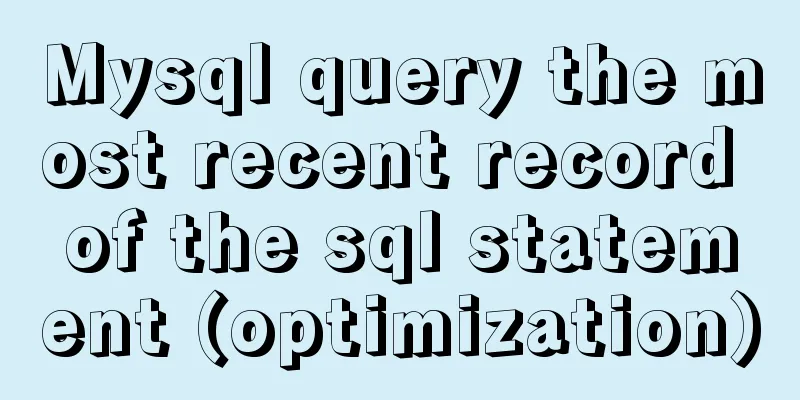Detailed explanation of MySql view trigger stored procedure

|
view: When a temporary table is used repeatedly, you can give it an alias to facilitate future use. You can then create a view, and the alias is the name of the view. A view is just a virtual table whose data is dynamically read from the physical table, so changes to the physical table will change the view. create: create view v1 as SQL For example: create view v1 as select * from student where sid<10 After creation, if you use the MySQL terminal, you can see a table called v1. If you use navicate, you can see that a view called v1 is generated in the view. When you use it again, you can directly use the query table method. For example: select * from v1 Modification: You can only modify the SQL statements in the view alter view view name as sql delete: drop view view name trigger: When adding, deleting, modifying, or checking a table (before, after, or after), you can use triggers to customize the associated behavior. Modify the terminator delimiter in the SQL statement before after
--delimiter //
-- before or after defines the operation before or after the operation (insert or other) -- on represents the trigger operation after the operation occurs on that table -- CREATE TRIGGER t1 BEFORE INSERT on teacher for EACH row
--BEGIN
-- INSERT into course(cname) VALUES('Ultraman');
--END //
--delimiter;
-- insert into teacher(tname) VALUES('triggertest111')
--
--delimiter //
-- CREATE TRIGGER t1 BEFORE INSERT on student for EACH row
--BEGIN
-- INSERT into teacher(tname) VALUES('Ultraman');
--END //
--delimiter;
-- insert into student(gender,sname,class_id) VALUES('男','1小刚111',3);
-- Delete trigger -- drop trigger t1;
-- NEW and OLD represent new and old data to make them consistent -- delimiter //
-- create TRIGGER t1 BEFORE insert on student for each row
--BEGIN
--Here new specifies the newly inserted data, and old is usually used for delete -- insert into teacher(tname) VALUES(NEW.sname);
-- end //
--delimiter;
insert into student(gender,sname,class_id) VALUES('男','蓝大蟹',3); Stored Procedure: Essentially, it is a collection of SQL statements, and then this collection is given an alias. The difference between a view and a table is that a view is a SQL query statement treated as a table. Way: 1 msyql----stored procedure for program calls 2 msyql---Do not do stored procedures, the program writes sql 3 mysql--do not do stored procedures, program write classes and objects (converted into sql statements) Creation method:
-- Calling a stored procedure
call p2(5,2)<br data-filtered="filtered"><br data-filtered="filtered"><em id="__mceDel"> cursor.callproc('p1',(5,2)) in pymysql</em>
-- 2 with parameter in parameter -- delimiter //
-- create PROCEDURE p2(
-- in n1 int,
-- in n2 int
-- )
--BEGIN
-- select * from student where sid<n1;
--
-- end //<br data-filtered="filtered"><br data-filtered="filtered"> call p2(5,2)<br data-filtered="filtered"><br data-filtered="filtered"><em id="__mceDel"> cursor.callproc('p1',(5,2)) in pymysql</em>
-- 3 out parameter When using out as a parameter in a stored procedure, the variable can be called externally -- There is no return in the stored procedure. If you want to call a variable externally, you need to use out
--delimiter //
-- create PROCEDURE p3(
-- in n1 int,
--out n2 int
-- )
--BEGIN
--set n2=444444;
-- select * from student where sid<n1;
--
-- end //
--
--delimiter;
--
-- set @v1=999 is equivalent to creating a variable at the session level -- set @v1=999;
-- call p3(5,@v1);
-- select @v1; #By passing a variable in and then monitoring this variable, you can monitor whether the stored procedure is executed successfully -- in pymsyql --
-- cursor.callproc('p3',(5,2))
-- r2=cursor.fetchall()
-- print(r2)
--
-- The stored procedure contains the out keyword. If you want to get the return value, cursor.execute('select @_p3_0,@_p3_1')
-- # Among them, 'select @_p3_0,@_p3_1' is a fixed writing method select @_stored procedure name_input parameter index position-- cursor.execute('select @_p3_0,@_p3_1')
-- r3=cursor.fetchall()
-- print(r3)
--Why do we need out to forge the returned value when we have a result set? Because the stored procedure contains multiple SQL statements, it is impossible to determine whether all SQL statements can be executed successfully. The out feature is used to identify whether the SQL statement is executed successfully. For example, if success is marked as 1, partial success is marked as 2, and failure is marked as 3 Transactions in stored procedures: Transactions: It is called atomic operation. DML (insert, update, delete) statements are completed together, and transactions are only related to DML statements, or only DML has transactions. Features of transactions: Atomicity A: A transaction is the smallest unit and cannot be divided. Consistency C: Transactions require that all DML statements must succeed or fail when they are executed. Isolation I: There is isolation between transaction A and transaction B Persistence D: It is the guarantee of the transaction and the sign of the end of the transaction (the data in the memory is completely saved to the hard disk) Transaction keywords: Start transaction: start transaction End of transaction: end transaction commit transaction Rollback transaction Basic operations of transactions
delimiter //
create procedure p5(
in n1 int,
out n2 int
)
begin
1 Statement if abnormal execution occurs (
set n2=1;
rollback;
)
2 Start transaction Buyer account - 100
Selling account +100
commit
3 End set n2=2
end //
delimiter ;
In this way, you can detect errors through n2 and roll back. The following is the detailed code delimiter //
create procedure p6(
out code TINYINT
)
begin
Declare that if a SQLException is encountered, execute the following operation DECLARE exit HANDLER for SQLEXCEPTION
begin
--error
set code=1;
rollback;
end;
START TRANSACTION;
delete from tb1;
insert into tb2(name)values('slkdjf')
commit;
---success
code=2
end //
delimiter ; Use of cursors in stored procedures:
delimiter //
create procedure p7()
begin
declare row_id int;
declare row_num int;
declare done int DEFAULT FALSE;
Declare a cursor declare my_cursor cursor for select id,num from A;
Declare that if there is no data, set done to True
declare continue handler for not found set done=True;
open my_cursor; open cursor xxoo; LOOP start loop called xxoo
fetch my_cursor into row_id,row_num;
if done then if done is True leave the loop leave xxoo;
end if;
set temp=row_id+row_num;
insert into B(number)VALUES(temp);
end loop xxoo; close the loop close my_cursor;
end //
delimiter ;
The above code is converted into Python
for row_id,row_num in my_cursor:
Check if there is any data in the loop, if not, break
break
insert into B(num) values(row_id+row_num)Dynamically execute SQL and place SQL injection at the database level:
delimiter \\
create procedure p6(
in nid int)
begin
1 Precompile (pre-check) the legitimacy of a certain sql statement 2 sql=format tpl+arg
3 Execute SQL
set @nid=nid
prepare prod from 'select * from student where sid>?'
EXECUTE prod using @nid;
deallocate prepare prod
end \\
delimiter ;The above is the full content of this article. I hope it will be helpful for everyone’s study. I also hope that everyone will support 123WORDPRESS.COM. You may also be interested in:
|
<<: How to connect Xshell5 to Linux in a virtual machine and how to solve the failure
>>: JS implements random generation of verification code
Recommend
Basic knowledge: What does http mean before a website address?
What is HTTP? When we want to browse a website, w...
Detailed example of clearing tablespace fragmentation in MySQL
Detailed example of clearing tablespace fragmenta...
jQuery plugin to achieve code rain effect
This article shares the specific code of the jQue...
MySQL online deadlock analysis practice
Preface I believe that everyone has had a simple ...
Steps to change mysql character set to UTF8 under Linux system
Table of contents 1. Check the MySQL status in th...
Summary of some practical little magic in Vue practice
How can you forget lazy loading of routes that al...
Vue integrates Tencent Map to implement API (with DEMO)
Table of contents Writing Background Project Desc...
Example to explain the size of MySQL statistics table
Counting the size of each table in each database ...
How to build a DHCP server in Linux
Table of contents 1. Basic knowledge: 2. DHCP ser...
Vue3 + TypeScript Development Summary
Table of contents Vue3 + TypeScript Learning 1. E...
How to create WeChat games with CocosCreator
Table of contents 1. Download WeChat developer to...
Comparison of the efficiency of different methods of deleting files in Linux
Test the efficiency of deleting a large number of...
Solve the error "Can't locate ExtUtils/MakeMaker.pm in @INC"
When installing mha4mysql, the steps are roughly:...
Tutorial on installing JDK Tomcat MySQL on Linux (remote access using Mac)
One environment Alibaba Cloud Server: CentOS 7.4 ...
Tutorial on how to connect and use MySQL 8.0 in IDEA's Maven project
First, let's take a look at my basic developm...









